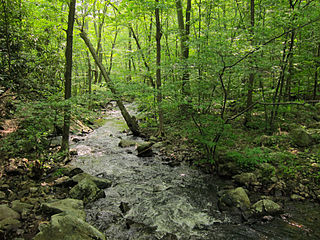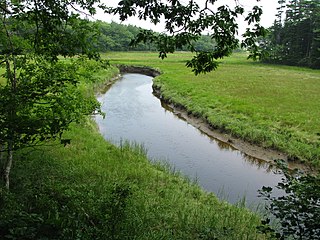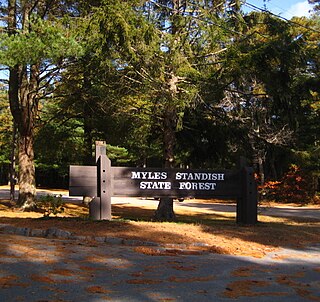
The Northeastern coastal forests are a temperate broadleaf and mixed forests ecoregion of the northeast and middle Atlantic region of the United States. The ecoregion covers an area of 34,630 sq miles (89,691 km²) encompassing the Piedmont and coastal plain of seven states, extending from coastal southwestern Maine, southeastern New Hampshire, eastern Massachusetts, and Rhode Island, southward through Connecticut, New York State, New Jersey, southeast Pennsylvania, Delaware and Maryland.

Drummond/North Elmsley is a township in eastern Ontario, Canada in Lanark County. It is situated on the north shore of the Rideau River between the town of Perth and the town of Smiths Falls. It is a predominantly rural municipality. The township offices are located in the hamlet of Port Elmsley.

Missisquoi National Wildlife Refuge is a National Wildlife Refuge located in the eastern shore of Lake Champlain in the U.S. state of Vermont. The refuge is in Franklin County in the northwest corner of the state near the International Boundary with Canada. It is the only National Wildlife Refuge located entirely in Vermont, and is administered by the United States Fish and Wildlife Service.

The Atlantic coastal pine barrens is a temperate coniferous forest ecoregion of the Northeast United States distinguished by its nutrient-poor, often acidic soils and a pine tree distribution naturally controlled by frequent fires.

Bon Secour National Wildlife Refuge is a 7,157-acre (29 km2) National Wildlife Refuge located in five separate units in Baldwin and Mobile Counties, United States, directly west of Gulf Shores, Alabama on the Fort Morgan Peninsula. The refuge serves as a resting and feeding area for migratory birds and as a sanctuary for native flora and fauna. The refuge is one of the largest undeveloped parcels of land on the Alabama coast.
The greater Plymouth, Massachusetts area hosts some of the most significant natural ecosystems in the Northeastern United States. Outwash from the last of numerous glacial periods left thick glacial deposits of sand and gravel, providing the geologic foundation for globally rare pine barrens. This fire-adapted forest is home to a host of rare species found almost nowhere else in the world. Interspersed among the 20,000 acres (80 km²) of pine barrens are dozens of remarkable coastal plain ponds. In addition to supporting federally endangered Plymouth Redbelly Turtles and globally rare plant communities, these ponds are windows on the Plymouth/Carver Sole Source Aquifer - the largest drinking water aquifer in the state of Massachusetts.

The Plymouth red-bellied turtle, sometimes called the Plymouth red-bellied cooter, the first freshwater turtle in the US to be listed as endangered, by the United States Fish and Wildlife Service was found only in Plymouth County, Massachusetts before the state began trying to establish populations in other areas. Current thinking is that they are not a full subspecies and that they belong in synonymy under Pseudemys rubriventris or northern red-bellied cooter. Nevertheless, it is well recognized that the Plymouth red-bellied turtle extends the range of the northern red-bellied cooter by 30–40 percent. In 1983, Massasoit National Wildlife Refuge was established to help conserve the Plymouth red-bellied turtle.

The Rachel Carson National Wildlife Refuge is a 9,125-acre (37 km2) National Wildlife Refuge made up of several parcels of land along 50 miles (80 km) of Maine's southern coast. Created in 1966, it is named for environmentalist and author Rachel Carson, whose book Silent Spring raised public awareness of the effects of DDT on migratory songbirds, and of other environmental issues.
Halfway Pond a 232-acre (0.94 km2) warm water pond located in Plymouth, Massachusetts between Myles Standish State Forest and Long Pond, west of Round Pond, southwest of Gallows Pond, and north of Fawn Pond and White Island Pond. The average depth is nine feet and the maximum depth is 13 feet (4.0 m). The pond is fed by the outflow of Long Pond and drains into the Agawam River. Halfway Pond Island lies in the middle of the pond and is managed as a research natural area by The Nature Conservancy in Massachusetts. There are almost three miles (5 km) of shoreline.
Curlew Pond is a 43-acre (170,000 m2) natural warm water pond in Plymouth, Massachusetts, located in the Myles Standish State Forest.
Boot Pond is a 76-acre (310,000 m2) pond in Plymouth, Massachusetts within the Eel River watershed. The pond is located west of South Pond village, northwest of Gunners Exchange Pond and Hoyts Pond, and north of Myles Standish State Forest. The pond is a secondary municipal water supply for the Town of Plymouth.
Barrett Pond is a 16-acre (65,000 m2), warm water pond in the Myles Standish State Forest in Carver, Massachusetts, located less than ½ mile north of the forest headquarters, west of East Head Reservoir, and southwest of College Pond in Plymouth. The pond has an average depth of six feet and a maximum depth of 17 feet (5.2 m). Most of the shoreline is undeveloped except for a campground area on the eastern shore. Access is possible off Lower College Pond Road and is suitable only for car top boats or canoes, electric motors only.

The Boggs Lake Ecological Reserve is a nature reserve in Lake County, California. The land area is about one quarter of a square mile and contains a large vernal pool as well as endangered plants such as the Boggs Lake hedge-hyssop.

Black Bayou Lake National Wildlife Refuge is one of five refuges managed in the North Louisiana Refuge Complex and one of 545 refuges in the National Wildlife Refuge System. It was established in 1997 through a unique partnership with the city of Monroe, Louisiana. The U.S. Fish and Wildlife Service has a free 99-year lease to manage the city-owned lake.

Currituck National Wildlife Refuge, located on the northern end of North Carolina's Outer Banks, was established in 1984 to preserve and protect the coastal barrier island ecosystem. Refuge lands are managed to provide wintering habitat for waterfowl and to protect endangered species such as piping plover, sea turtles, and seabeach amaranth.

The Middle Atlantic coastal forests are a temperate coniferous forest mixed with patches of evergreen broadleaved forests along the coast of the southeastern United States.

The Southeastern conifer forests are a tropical and subtropical coniferous forest ecoregion of the southeastern United States. It is the largest conifer forest ecoregion east of the Mississippi River.














